SEO doesn’t need to be complicated. In fact, you can skyrocket your traffic and get amazing results for your business with a solid SEO strategy.
If you’ve been hit by Google’s helpful content update in Sept 2023, this is a guide to get you back on track.
In this article, I’ll show you how to create an SEO strategy that will get the results you’re after by focusing on the importance of each blog post in content creation for SEO.
Bookmark this article as your comprehensive guide to revisit later. I’ve covered all of the essential steps, from conducting keyword research using tools like Ahrefs or SEMrush, to analyzing your competitors’ strategies and optimizing for on-page SEO.
Get ready to take your website to the next level!

A Search Engine Optimization (SEO) Strategy is a plan aimed at increasing organic search rankings and website traffic, thereby boosting visitors and revenue for online businesses.
Before diving into the nitty-gritty of SEO tactics, it’s crucial to understand the fundamentals of SEO and set clear, achievable goals. SEO, or Search Engine Optimization, is the practice of optimizing your website to rank higher in search engine results pages (SERPs) and attract more organic traffic. By setting specific goals, you can measure your progress and adjust your strategy as needed.
Benchmarking your current SEO performance is essential to understand where you stand and set realistic goals. To do this, you’ll need to track key metrics such as:
Organic traffic: The number of visitors who come to your site from unpaid search results.
Keyword rankings: The position of your website in search engine results pages (SERPs) for specific keywords.
Backlinks: The number of links from other websites to your site.
Average CTR (Click-Through Rate): The percentage of users who click on your site after seeing it in search results.
Indexing issues: Errors that prevent search engines from crawling and indexing your site.
Use tools like Google Search Console, Google Analytics, and Ahrefs to track these metrics and get a comprehensive picture of your site’s performance. By understanding your current standing, you can set a baseline and measure the impact of your SEO efforts over time.
Setting clear goals and key performance indicators (KPIs) helps you evaluate your SEO efforts and make data-driven decisions. Your goals should be specific, measurable, achievable, relevant, and time-bound (SMART). Examples of SMART goals include:
Increase organic traffic by 20% in the next 3 months.
Improve keyword rankings for 5 target keywords in the next 6 months.
Increase average CTR by 15% in the next 2 months.
Use tools like Google Analytics to track your KPIs and adjust your SEO strategy accordingly. By setting and monitoring these goals, you can ensure that your SEO efforts are aligned with your business objectives and are driving the desired results.
When developing an effective SEO content strategy, there are four key pillars to focus on; keyword research, content optimization, backlinks, and technical SEO.
These are the bread and butter of SEO. If you do nothing else, focus on these four principles.
Keyword research is crucial because it helps you understand what terms people are searching for and how competitive those keywords are.
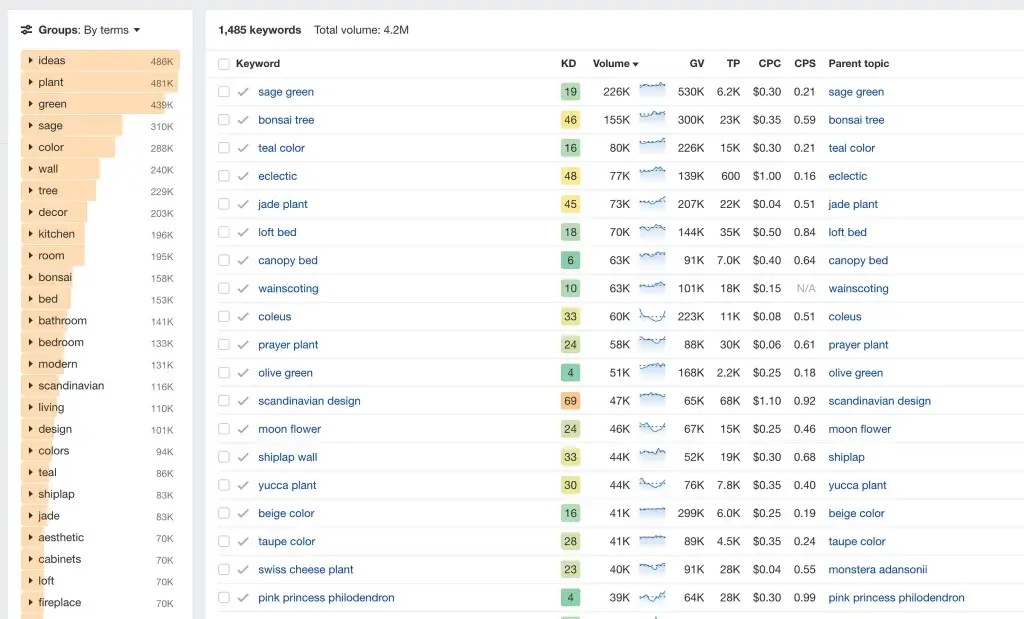
Keyword Research in Ahrefs
Boost Organic Traffic: By targeting the right keywords, you can attract more organic traffic to your website. When you optimize your content around these keywords, Google will be more likely to rank your site higher in search results.
Improve Ranking: Keyword research allows you to identify the keywords that your target audience is using. By incorporating these keywords into your content, meta tags, and headings, you can improve your chances of ranking higher in search results.
Content optimization involves improving the quality and relevance of your website’s content to attract more organic traffic and improve rankings.
Start by conducting keyword research to identify relevant keywords that have high search volume and low competition.
Once you have a list of target keywords, incorporate them strategically throughout your content, including in headings, meta tags, and body text.
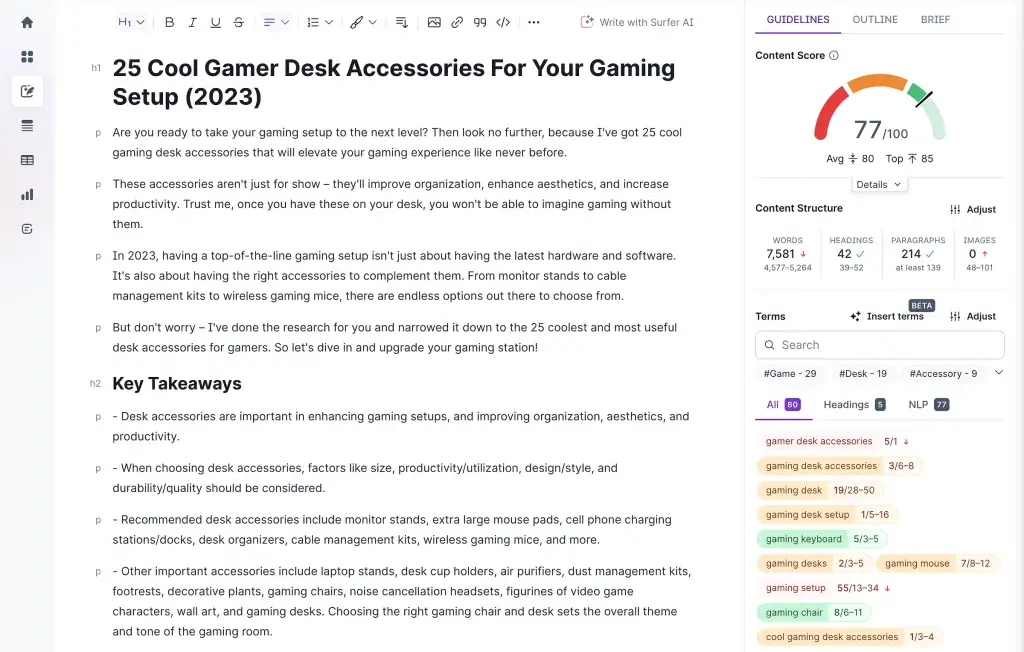
SurferSEO Content Editor
Make sure your content is well-structured, easy to read, and provides valuable information to readers. Additionally, keep your blog posts updated with current information and integrate SEO best practices to maintain or improve their visibility in search engine results.
Understanding the importance of backlinks in your SEO efforts and how they can positively impact your rankings is crucial.
Backlinks are links from other websites that point to your site, and they play a significant role in determining the credibility and authority of your website. When reputable websites link to your content, it signals to search engines that your website is trustworthy and valuable.
This can result in higher rankings, increased website traffic, and improved visibility in organic search results.
Technical SEO can improve your website’s performance and enhance its visibility in search results.
If you’re not technical, this is definitely an area to outsource!
Here are five key aspects of technical SEO:
Site speed optimization: Ensure your website loads quickly to provide a positive user experience and reduce bounce rates.
Mobile optimization: Optimize your website for mobile devices to cater to the increasing number of mobile users.
URL structure: Use descriptive, keyword-rich URLs that are easy for both users and search engines to understand.
Schema markup implementation: Add structured data markup to help Google better understand and display your content in search results.
XML sitemap creation: Create an XML sitemap to help search engines crawl and index all the pages on your site.
It’s essential to analyze your competitors to gain valuable insights.
To effectively identify your competitors, follow these steps:
Conduct keyword research to find which websites are ranking for the same keywords as you (Use Ahrefs or SEMrush).
Analyze the top-ranking pages in search results for your target keywords to see who you’re up against.
Use tools like SEMrush or Ahrefs to gather data on your competitors’ rankings, backlinks, and organic traffic.
Perform a backlink gap analysis to uncover websites that are linking to your competitors but not to you.

Content gap analysis on Ahrefs
To effectively analyze your competitors, it’s important to discover the valuable keywords they currently rank for. By identifying your competitors’ valuable keywords, you can gain insights into their successful SEO strategy and incorporate those learnings into your own keyword strategy.
Analyzing your competitors’ backlinks can provide valuable insights and help you identify potential opportunities to improve your own website’s rankings.
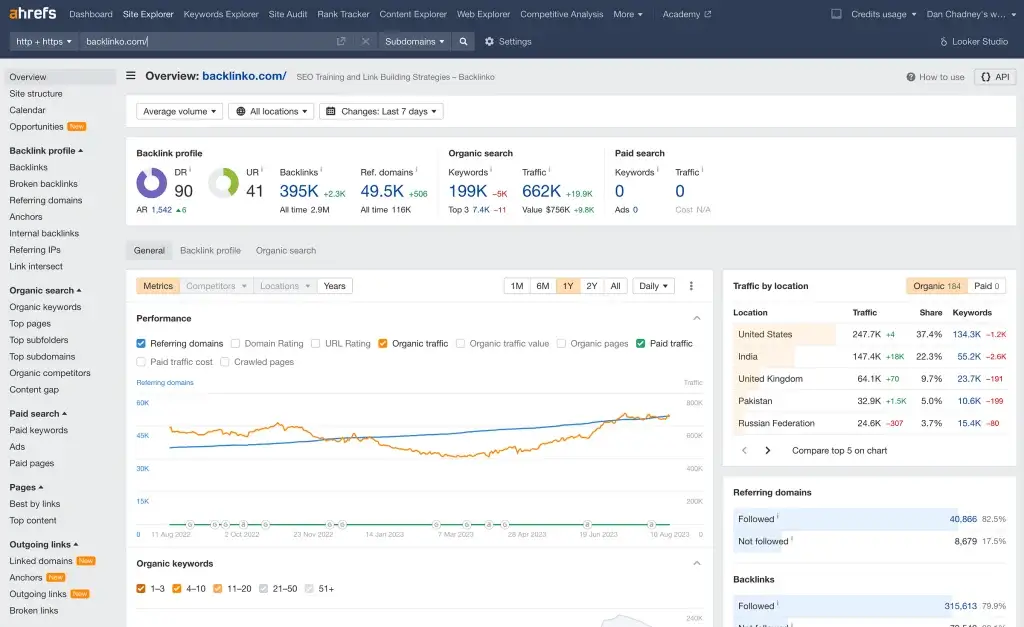
Competitor research on Ahrefs
Here are three reasons why auditing your competitors’ backlinks is crucial:
1. Uncover Link Building Opportunities: By analyzing your competitors’ backlink profiles, you can identify websites that are linking to them but not to you. This presents an opportunity to reach out to those websites and request a link, potentially boosting your own rankings.
2. Learn from Successful Strategies: Studying the types of websites that link to your competitors can give you insights into the kind of content or partnerships that work well in your industry. You can then replicate those strategies in your own SEO efforts.
3. Identify Weaknesses and Improve: If your competitors have low-quality or spammy backlinks, it’s an opportunity for you to differentiate yourself by acquiring high-quality, relevant links. Conducting a thorough backlink audit allows you to evaluate the strengths and weaknesses of their link profile and make informed decisions for improving yours.
Start by conducting keyword research and using SEO tools like Semrush, Ahrefs, Ubersuggest, or Google’s search features to find search volume and competition data for your chosen keywords. This step is crucial. By having a comprehensive list of keywords, you can optimize your website’s content and ensure that it aligns with what users are searching for.
Often long-tail keywords have lower competition that can help drive organic traffic to your site.
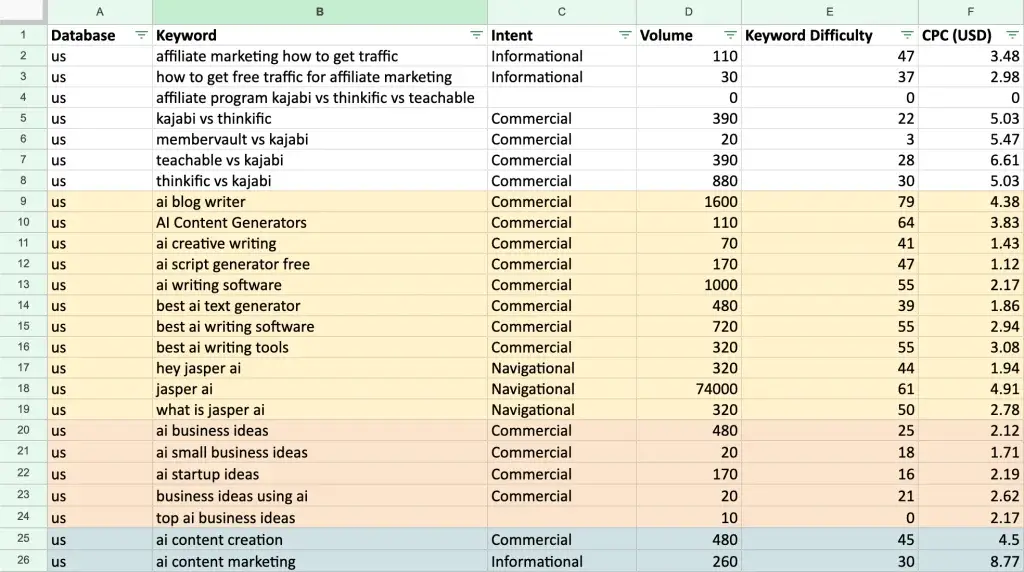
Keyword research spreadsheet showing search volume, keyword difficulty, and search intent.
Search engines can help you find relevant keywords and phrases for your SEO strategy. Use tools like Google Keyword Planner, Ahrefs Keyword Explorer, or SEMrush to:
Identify keywords with high search volume and low competition.
Analyze your competitors’ keywords and identify gaps in the market.
Find long-tail keywords and phrases that are more specific and less competitive.
By leveraging these tools, you can discover the keywords that your target audience is searching for and create content that meets their needs. This will help you attract more organic traffic and improve your search engine rankings.
Long-tail keywords and phrases are more specific and less competitive than generic keywords. They can help you attract targeted traffic and improve your conversion rates. Use tools like Google Keyword Planner or Ahrefs Keyword Explorer to identify long-tail keywords and phrases that are relevant to your business.
Examples of long-tail keywords and phrases include:
“Best Italian restaurants in New York City”
“How to create a successful SEO strategy”
“Top 10 SEO tools for small businesses”
Use these long-tail keywords and phrases to create high-quality content that resonates with your target audience. By focusing on these specific terms, you can attract users who are more likely to convert, thereby improving your overall SEO performance.
When considering search intent, you should focus on understanding the purpose behind a user’s search query in order to create content that satisfies their needs and increases your visibility in search results.
The main types of search intent are: informational, transactional, navigational, and commercial.
Analyze your keywords carefully to determine the search intent. This will directly affect what type of article you will write.
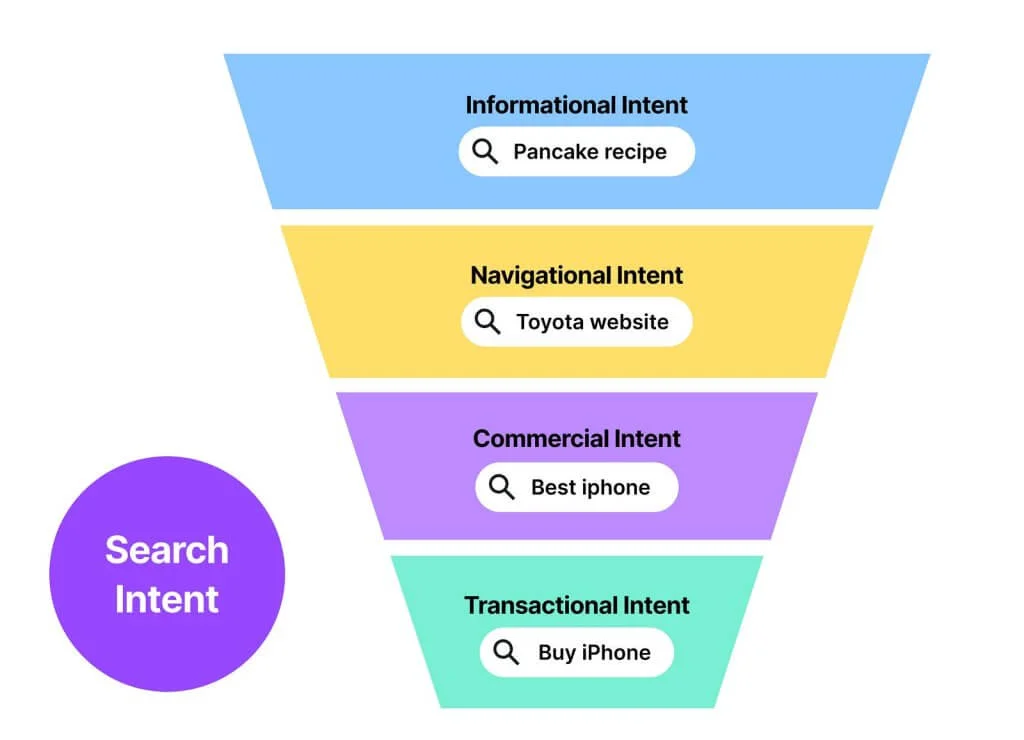
Search Intent Chart
Creating a content strategy using the Pillar/Cluster framework is a highly effective way to organize and optimize your website’s content in a way that is both strategic and user-friendly.
It will boost your website’s visibility and authority in Google search results while also providing valuable content for your audience.
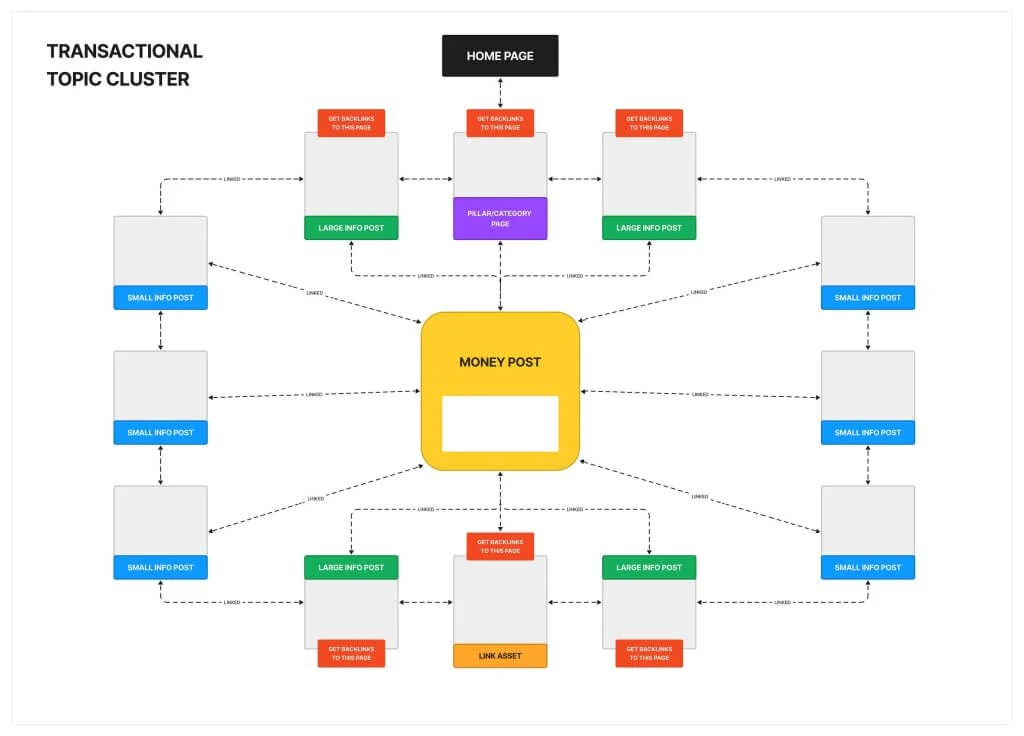
Topic cluster example showing internal and external linking strategy
The first step is to identify the main topics or themes that are most important to your business, which will serve as the foundation, or pillar pages, for your content.
When selecting a topic, consider your target audience and their interests, as well as the relevance and competitiveness of the topic in search results. By choosing a topic that aligns with your business or website goals, you can create content that resonates with your audience and helps improve your rankings.
Start by outlining your pillar (topic) and cluster structures to organize your content effectively. Here’s how:
Identify your pillar topic: Choose a broad topic that’s relevant to your website or business. This will be the main focus of your strategy.
Create cluster topics: Break down your pillar topic into smaller, more specific subtopics called clusters. These clusters should be closely related to the pillar topic and can cover different aspects or angles of it.
Interlink the content: Once you’ve outlined your pillar and cluster topics, create content for each cluster. Make sure to interlink these pages with each other and with the pillar page. This will help Google understand the relationship between the topics and improve overall visibility.
To improve your site’s visibility and rankings, you need to create content that is different or better than what already exists in your niche.
This means offering valuable information, insights, or solutions that are not readily available elsewhere.
This will help you attract more organic traffic, engage your audience, and earn backlinks from authoritative sites.
When creating content, adding a personal touch is always important. Sharing personal experiences and insights not only demonstrates expertise but also adds authenticity and relatability to the content.

Sharing personal experiences in content helps readers relate and search engines better understand context
Writing about topics that you have personal experience with allows you to provide valuable and trustworthy information, ultimately enhancing your E-E-A-T (Experience, Expertise, Authoritativeness, and Trustworthiness) and improving your content’s credibility.
Go beyond just sharing experience and link to external sources that show your authority on the subject.
Your strategy should also include citing facts and include links to the sources of your facts to show Google, and your readers, that you’ve done your research.
This is more important than ever, and is especially important if you’ve been affected by Google’s Helpful Content update.
When optimizing your content for search engines, there are several key points to consider.
Make sure that you structure your articles semantically.
H1 headings should be used once per page for your main page title.
A well-crafted meta description is crucial for on-page SEO as it serves as a concise summary of the webpage content, helping search engines and users understand what to expect from the page.
H2 headings should make up the majority of additional headings.
Nest H3 and H4 headings inside H2 sections.
SEO optimization tools can be used to enhance the performance of your website’s content.
NLP, or Natural Language Processing, is a branch of artificial intelligence that helps machines understand and interpret human language. These tools will help you improve your website’s visibility on the search engine results page (SERP) and attract more organic traffic.

NLP Keyword analysis
These tools analyze the structure, context, and relevance of your content to suggest improvements for better search engine rankings. Incorporating NLP techniques into your content allows you to create high-quality, user-friendly content that aligns with search intent and drives engagement.
Check out SurferSEO, Neuron Writer, or Frase.
Internal linking is crucial for optimizing your website’s SEO and is often undervalued. Here are four reasons why it is important:
Building trust: Internal links help establish a clear and logical structure within your site, making it easier for users and search engines to navigate.
Improving user experience: Internal links provide a seamless browsing experience by guiding users to related content they may find valuable. This helps increase user engagement and time spent on your site, which are important ranking factors.
Enhancing SEO performance: Search engines follow internal links to discover new content and understand the relationships between different pages.
Solidifying SEO strategy: Strategic internal linking allows you to prioritize certain pages or keywords for better optimization. Important pages receive more authority from other linked pages, boosting their chances of ranking higher in search results.
I’ve mentioned it a few times, but backlinks are crucial for increasing the visibility and authority of your website. They act as the backbone of SEO, boosting your rankings.
Domain Authority (DA) is a metric used to determine the strength and credibility of a website, based on its backlink profile.
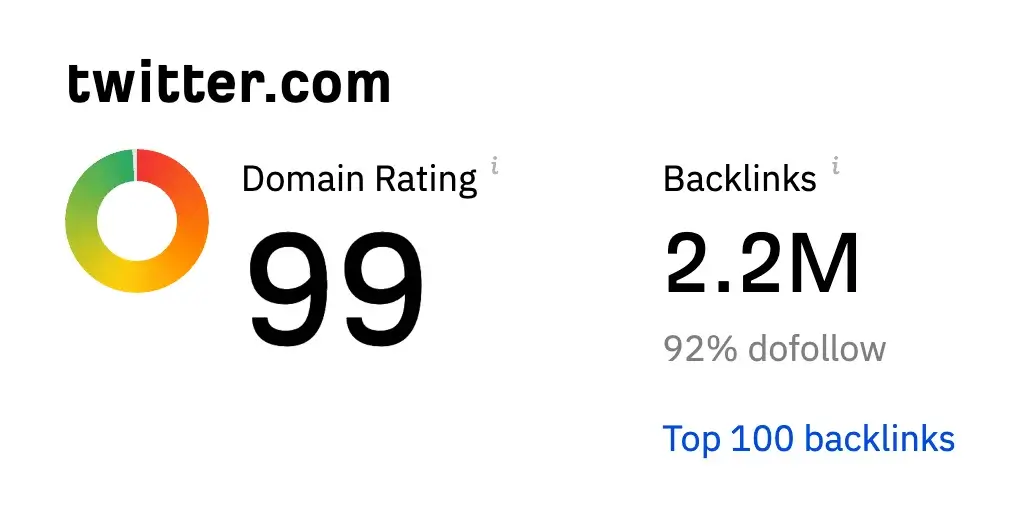
Domain Authority (DA) or Domain Rating (DR)
Google considers backlink domain authority as a vote of confidence from other reputable websites, giving your own site more credibility and improving its chances of ranking higher in search results pages.
Here are a few ways you can get backlinks:
Guest posting is a valuable strategy for building backlinks and increasing visibility in search results. By writing high-quality content for other websites in your industry, you can attract an audience and drive traffic back to your own website. Just make sure to include a link to your site!
This not only helps with off-page SEO but also provides readers with an easy way to navigate back to your website if they find your content valuable.
To maximize the benefits of guest posting, choose websites that have a relevant audience and a strong domain authority.
HARO is a platform that connects journalists and experts, providing an opportunity for you to get featured in high-authority publications.

Help A Reporter Out (HARO)
Here’s how it works:
Sign up as a source on HARO and receive daily emails with reporter queries related to your expertise.
Respond to relevant queries with valuable insights and information.
If your response gets selected, you’ll be quoted or mentioned in the article along with a backlink to your website.
HARO can be highly effective for building brand authority, generating backlinks, and increasing visibility.
Building link assets involves creating valuable resources that will attract links from reporters, journalists, and other bloggers.
These link assets can be in the form of statistics, templates and guides, calculators, or even glossaries.
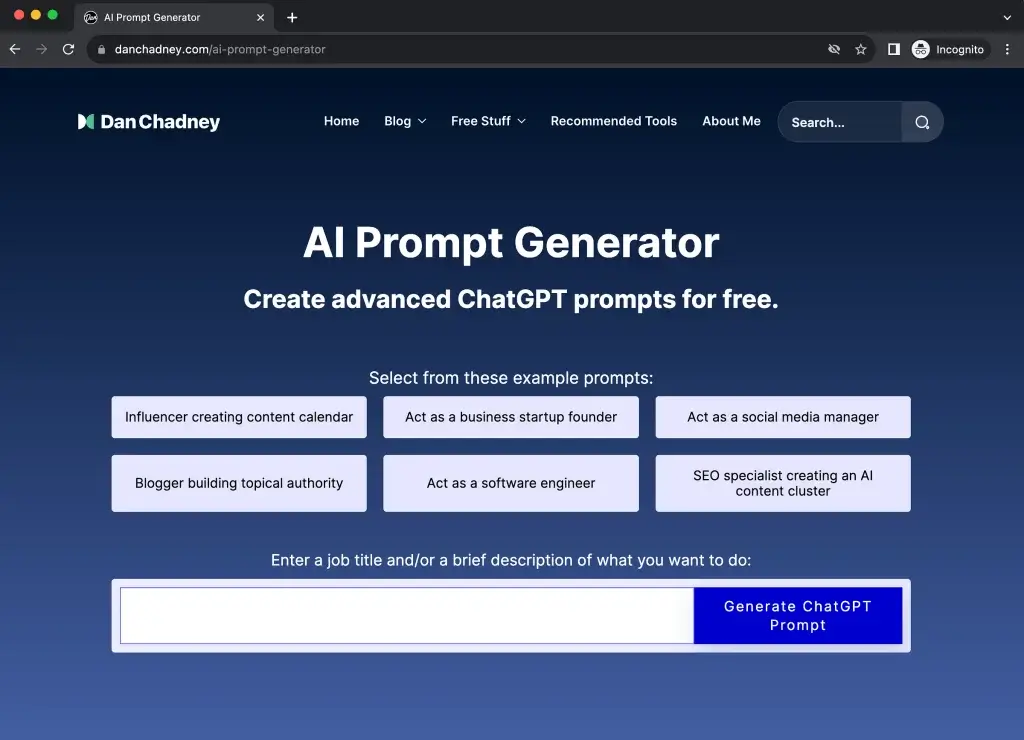
Example of a link asset from DanChadney.com (now indiebrandbuilder.com!)
By providing these high-value resources, you increase the chances of others linking to your website or content, thereby improving your search rankings and increasing your online visibility.
Identifying and resolving technical SEO issues is crucial for optimizing your website’s performance and search rankings.
As you create your strategy, it’s important to prioritize finding and fixing these issues.
It will improve the user experience on your website and make it easier for search engines to understand and index your content.
Address any technical issues such as broken links, slow page loading speed, and duplicate content.
Ensure that your URLs are short and keyword-rich. Short URLs tend to perform better in search engine optimization.
Regularly auditing your site for technical issues is essential to ensure that your website is running smoothly and effectively.
SEMrush does a great job of this with the Site Audit tool. It will show you in detail everything that you need to change or update and boost your score.
Regularly updating and improving your content is crucial for maintaining a strong online presence.
Not only do regular updates signal to Google to re-index your site, but it also keeps your content fresh and up to date.
By adding new information or removing outdated material, you can ensure that your audience receives the most relevant and accurate information.
Making keyword or SEO improvements can significantly impact your post’s search engine rankings, helping to increase its visibility and reach.
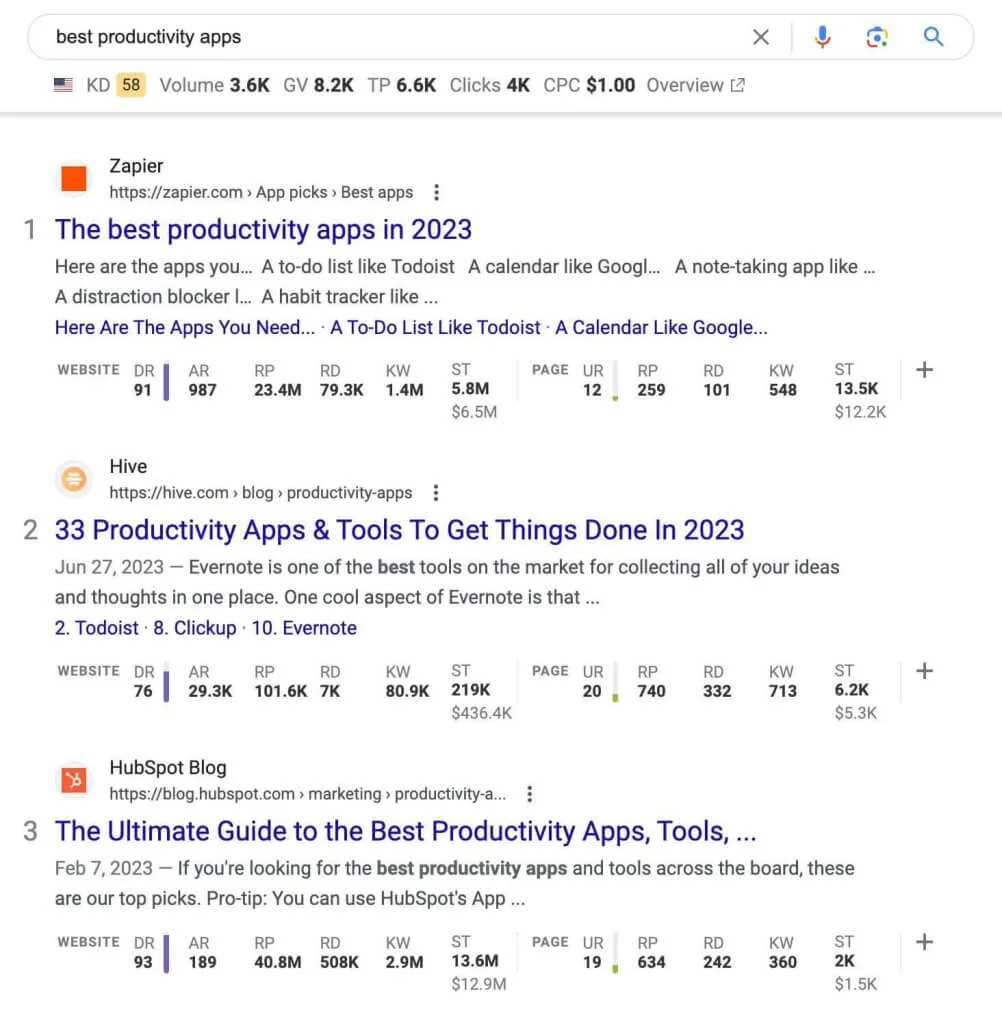
Monitor your rankings with Chrome extensions from Ahrefs and SurferSEO
Bad SEO practices should be avoided to ensure the effectiveness and success of your website’s search engine optimization efforts.
Keyword stuffing involves excessively using keywords in your content to manipulate search rankings. This not only makes your content appear spammy but also negatively affects user experience.
Avoid buying backlinks from low-quality or irrelevant websites. While backlinks are important for SEO, acquiring them through unethical means can result in penalties from search engines.
Stay away from duplicate content and cloaking techniques that deceive search engines.
Take a look at your existing content and make updates to ensure it remains relevant and valuable to users.
To historically optimize your content, analyze the top-ranking pages for a keyword and note any patterns in their content format.
This will help you understand what type of content is performing well in terms of SEO. Here are three key points to consider when analyzing the top-ranking pages:
Content Format Patterns:
Look for commonalities in the structure and layout of the top-ranking pages.
Pay attention to headings, subheadings, bullet points, and other formatting elements.
Note how they incorporate multimedia such as images or videos.
Keyword Usage:
Analyze how the top-ranking pages use keywords throughout their content.
Look for keyword placement in titles, meta descriptions, headers, and body text.
Observe if they use variations or synonyms of the target keyword.
User Experience:
Evaluate how user-friendly and engaging the top-ranking pages are.
Consider factors like page load speed, mobile-friendliness, and overall design.
Take note of any interactive features or calls-to-action that encourage user engagement.
Keep an eye out for evolving keywords and shifting search intent to stay ahead in your SEO efforts. As you build an SEO process, it’s crucial to adapt to changing keywords and new search intent.
Start by creating a list of relevant keywords that align with your target audience’s search queries. This will serve as the foundation for your SEO roadmap. Regularly analyze keyword trends and update your strategy accordingly.
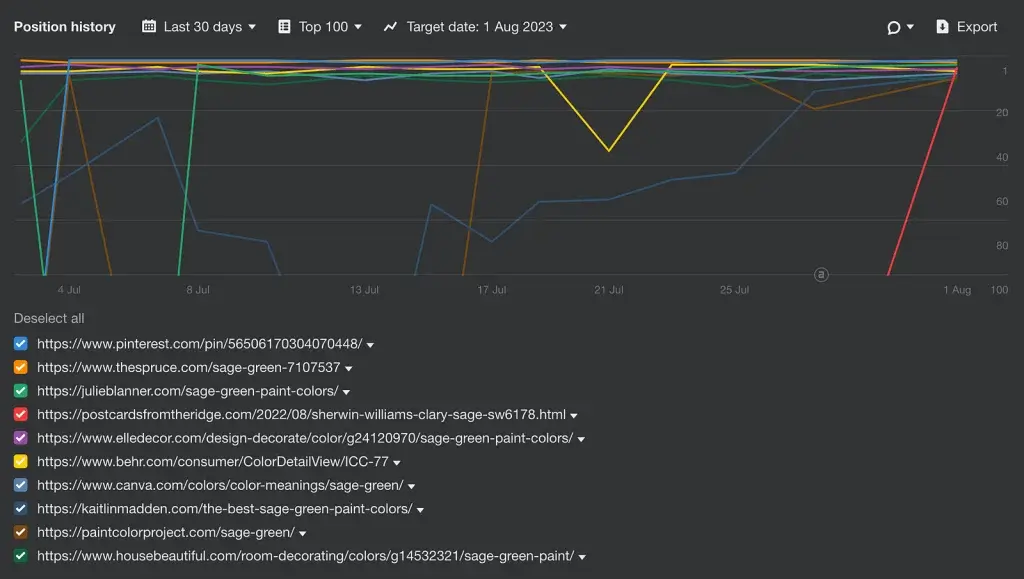
Example of historical data in Ahrefs
A well-executed digital marketing strategy involves creating fresh, high-quality content regularly. This not only keeps your website updated but also signals to Google that your site is active and relevant.
Remember that quality matters just as much as quantity when it comes to creating new content. Focus on providing value to your audience and addressing their needs or pain points.
To refine your strategy, analyze the performance of your keywords, backlinks, and organic traffic to identify areas for improvement. This analysis will help you make data-driven decisions and optimize your strategy for better results.
Here are three key steps to effectively analyze and refine your SEO strategy:
Keyword Analysis: Examine the performance of your target keywords in terms of search volume, competition level, and relevance to your content. Identify high-performing keywords that drive organic traffic and conversions.
Backlink Evaluation: Evaluate the quality and quantity of backlinks pointing to your website. Look for opportunities to acquire high-quality backlinks from authoritative sources within your industry.
Organic Traffic Assessment: Monitor the amount and quality of organic traffic coming to your site. Analyze trends, identify pages with low traffic or high bounce rates, and optimize them for better search engine results.
